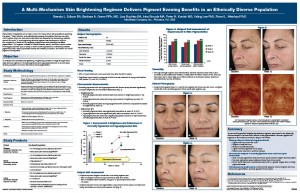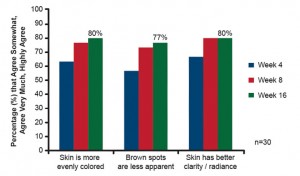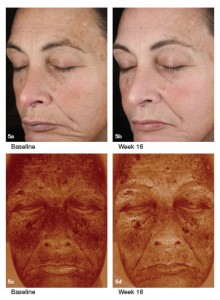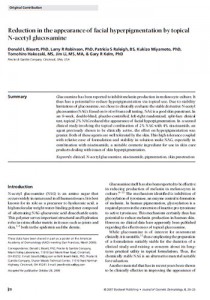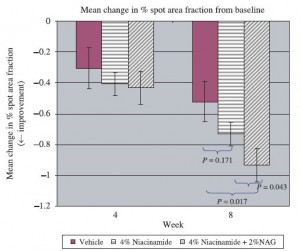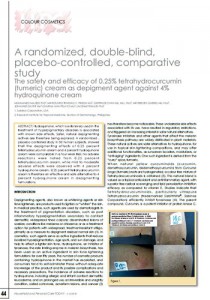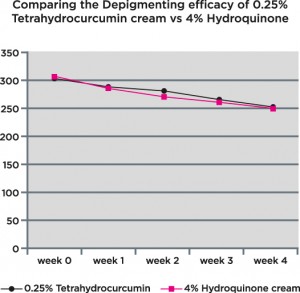All NeoStrata technologies are backed by strong researches and clinical studies. The products are extensively tested before launching to the public.
Multi-Mechanism Skin Brightening Regimen Delivers Pigment Evening Benefits in an Ethnically Diverse Population
Abstract: A new brightening skincare regimen was developed to improve the complexion of facial skin by targeting multiple steps and pathways that affect pigmentation. The regimen consists of a facial cleanser, serum and lotion, which contain N-acetyl glucosamine* plus a variety of other benefit ingredients to collectively exfoliate pigmented areas, reduce tyrosinase activity and melanin production, and deliver an overall pigment evening effect.
*Define: N-acetyl glucosamine is known as NeoGlucosamine® in NeoStrata products.
Overall improvement in skin pigmentation
- 93% of users achieved a more even skin tone after the first 4 weeks.
- 60% of subjects noticed an improvement as early as 2 weeks.
- 90% of subjects rated excellent, very good or good improvement after 16 weeks.
- Users reported more even pigmentation, less obvious brown spots, and improved clarity and radiance at the end of the 16 weeks visit.
Photography evidence of improvement with the use of the regimen
Marked improvement in pigmentation in standard lighting photographs and in cross-polarized photographs with melanin imaging applied to visualize hyperpigmented areas.
- Visual grading and clinical photos showed
- Lighter and more even skin colour
- Brighter overall skin tone
- Reduced overall sallowness
- Lighter and less apparent brown spots
- Effects were observed in all ethnic groups
- Self-assessment questionnaires confirmed that subjects noticed brighter skin tone, more even pigmentation, and less apparent brown spots
Brenda L. Edison, BA, Barbara A. Green, RPh et al., 27 – 30 September 2012. Poster presented at the 21st Congress of the European Academy of Dermatology & Venereology, Prague, Czech Republic.
Reduction in the Appearance of Facial Hyperpigmentation by Topical N-Acetyl Glucosamine
Abstract: Glucosamine has been reported to inhibit melanin production in melanocyte culture. It thus has a potential to reduce hyperpigmentation via topical use. Due to stability limitations of glucosamine, we chose to clinically evaluate the stable derivative N-acetyl glucosamine (NAG)*.
*Define: N-acetyl glucosamine is known as NeoGlucosamine® in NeoStrata products.
Benefits of N-acetyl glucosamine for facial hyperpigmentation
Analysis of Caucasian facial digital images for change in spot area fraction. More negative numbers indicate reduction in hyperpigmentation.
- Through an 8 weeks study, it was shown that NAG was effective in improving the overall appearance of facial hyperpigmentation.
- NAG lightens the hyperpigmentation through the inhibition of melanin production – a dark pigment that causes visible hyperpigmentation on the skin.
- Other than being an effective compound to improve hyperpigmentation, NAG help in synthesizing Hyaluronic acid, providing hydration and anti-aging benefits to the skin.
- NAG is well tolerated by the skin and is a suitable ingredient for skin care products.
Bissett, D L., et al. 2007. Reduction in the Appearance of Facial Hyperpigmentation by Topical N-Acetyl Glucosamine. Journal of Cosmetic Dermatology, 6 pp. 20-26.
The safety and efficacy of 0.25% Sabiwhite cream as depigment agent against 4% hydroquinone cream
Abstract: A randomized, placebo controlled study in 50 human subjects, showed that the depigmenting effects of 0.25% Sabiwhite® cream and 4% hydroquinone cream were comparable in a four week trial. 0.25% tetrahydrocurcumin cream is therefore an effective and safe alternative to 4% hydroquinone cream in depigmenting formulations.
- Potent antioxidant properties in Sabiwhite® quench the free radicals from harmful UV rays.
- At the end of the study, none of the subjects using Sabiwhite® cream reported adverse reaction.
- The whitening effect of 4% hydroquinone is comparable with 0.25% Sabiwhite® throughout the study.
- 0.25% Sabiwhite® is therefore an effective and safe alternative to 4% hydroquinone cream in depigmenting formulations.
Majeed, M, et al., 2010. Household and Personal Care TODAY, 3 pp. 44-46.

